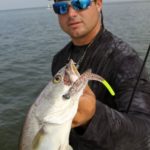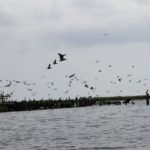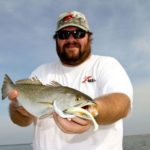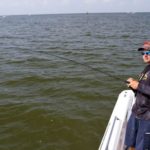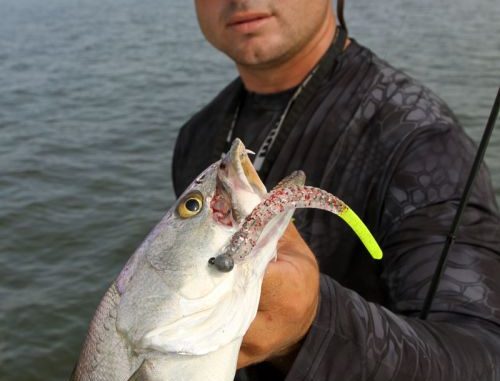
If September cool fronts don’t materialize, Breton Sound trout fishing can get pretty sluggish. But these captains say success is just a matter of slowing things down to reach fish in comfort zones.
I could tell he was getting a little impatient. Capt. Ross Montet knew there were loads of speckled trout in the warm shallows skirting Breton Island.
Two key words in that sentence: “loads” and “warm.”
This time of year does, indeed, find trout both stacked around the barrier islands and hanging out in the breeze of Breton Sound.
The only problem is that sweltering heat has the water temperatures in the upper 80s to low 90s. Fall’s approach promises more civilized conditions, but for another handful of weeks anglers can expect the fish to be significantly impacted by the dog days.
That’s what had Montet sighing heavily and gazing around with that look of borderline exasperation.
It didn’t help that 75 yards away, a handful of wade fishermen were whacking the specks pretty well — while a couple of boats between us and the island were doing the same.
Fishermen watch one another, and I put my 400mm lens to work confirming that no one was throwing anything vastly different than the lead-head jigs and Z-Man plastics we were chunking.
So why were we struggling?
Within a second of his first decent bite, Montet looked at me with a tight grin and the confident nod of a man who had figured out his quarry.
“You’ve got to fish it right on the bottom — that’s the only way they’ll bite it,” Montet said. “I had looked away for a second, and when my bait was dragging the bottom, that’s when he hit it.”
As Montet explained, the trout are active in the early morning hours this time of year, but once the heat index soars and that shallow water warms, trout hunker down and sit tight
Apparently, we had reached that point.
“We were going low and slow because the fish were holding deeper in the cooler water,” Montet said. “The oxygen levels are higher in the lower water column, and that makes the trout more likely to feed.”
Joe DiMarco, also out of Cajun Fishing Adventures, said there’s another factor at work.
“The saltier water is always going to be deeper because saltwater is heavier,” DiMarco said. “Being in that saltier water stresses them less. Also, that cooler water stressed them less.”
Now, finding this zone of comfort is more than simply moving progressively deeper. That might help on the macro level, but for specific targeting, DiMarco looks for tide-worn furrows flanking coastal islands.
“Use your depth finder to locate the troughs,” he said. “They act like little channels that guide the bait and the predators.
“Those troughs have little humps that deflect the current as it runs through these deeper spots. It may only be a foot or 2 difference, but those predators will sit there and use those humps as feeding spots because they redirect the water and the baitfish.”
Essential to moving current is the daily tide cycles. Water flowing in either direction is key to stimulating the fish, but DiMarco pointed out that incoming tides tend to bring cooler, saltier and well-oxygenated water.
Particularly powerful on a full moon but nonetheless relevant on lesser phases, incoming tides rejuvenate the coastal troughs and ring trout’s dinner bell.
During our Breton trip, catching a couple of channel mullet, croakers and flounder encouraged Montet. Such bycatch, he said, indicates the high salinity that trout favor.
However, he can do without those long, skinny, slimy, deck-pooper nuisances that jump a lot.
“When the lady fish show up, the shark population triples by the islands,” Montet said. “When this happens, the trout will hunker down on the bottom.
“You’ll notice sores on their bellies when they’ve been holding at the bottom; they’re just trying to lay low and stay camouflaged, and avoid getting eaten.”
Weather also plays a big part in the late-summer trout game, and storms bristling with lightning can bring about brief periods of electrified trout action.
Montet knows that, even when a storm skirts his area, the associated cloud cover keeps those comfy daybreak conditions in play.
“It will extend the cooler air temperatures and keep the water from rising, so expect to find the trout active a little later into the day when this happens,” Montet said. “The only good thing about summer showers is that they don’t last long.
“So, if you get chased off your spot by a popup storm, at some point in the day you will be able to run around and come back to that spot.”
DiMarco said the drop in barometric pressure ahead of a storm also is important.
Between the hostile weather, he at least wants a light wind to break up the surface and put the trout at ease.
“You want to be able to get out there safely, but I don’t like a dead calm,” DiMarco said. “The trout can hear everything. You can spook them just by stepping up on hatch.”
What to offer
In beach troughs, DiMarco likes 1/8-ounce jigs and smaller tails like cocahoe minnows, although if he’s fishing deeper than a few feet, he might go heavier to get the bait down and remain visible.
But smaller is his preference.
“I like a lighter jighead because it’s not just moving up and down with the stroke of your rod tip,” DiMarco said. “With a lighter jighead, when you twitch your rod tip, it might travel left and right just like a natural piece of bait that’s moving with the current.”
Montet’s also a fan of light jigs, and he’ll try a variety of tail designs from a standard minnow/shad tail to straight-tail baits like the Z-Man Trout Trick.
For live baiting shrimp or pogies, he’ll employ a cork for targeted presentations.
DiMarco starts with long casts to scout out an area and find pods of fish. Once he dials into the hotspots, he’ll play it closer to the boat for tactical advantages.
“I think you have a better chance of a hookup with a shorter cast because you have better control over what your bait’s doing,” DiMarco said.
Worth a mention here is the fact that, when the trout are hunkered down, many of your bites will be little more than modest pickups. It might only feel like your bait hit a shell, but set the hook at the slightest tick.
“Pay attention and watch your rod tip,” Montet explained. “It can get boring when the bite is slow, but that’s what you have to do.”
Braided line helps, but make sure you top it with a piece of fluorocarbon leader because trout are sight feeders with keen discernment.
Bites are tough this time of year, so don’t give them any more reasons to pass up your well-placed bait.
